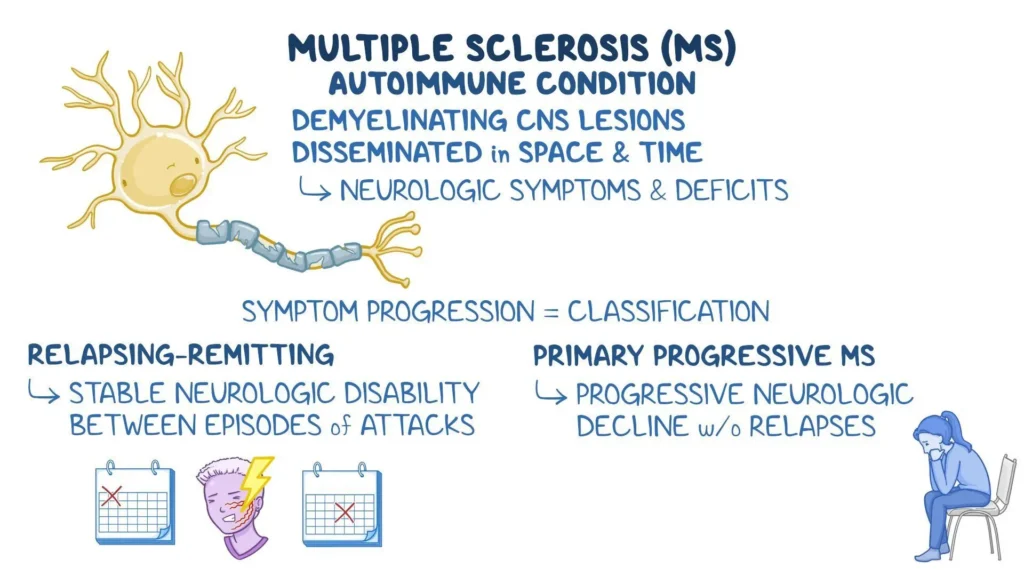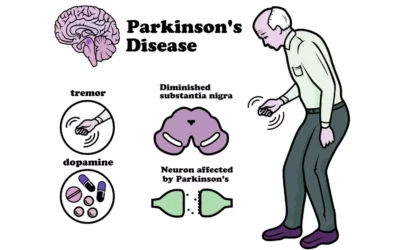Multiple sclerosis (MS) is a chronic, often debilitating disease of the central nervous system (CNS) that affects millions of people worldwide. It involves the immune system mistakenly attacking healthy tissues, particularly the protective sheath (myelin) around nerve fibers in the brain and spinal cord. This disruption impedes the normal flow of electrical impulses, leading to a wide range of neurological symptoms. Though there is no cure for MS, advancements in research, early diagnosis, and new treatment options have greatly improved the quality of life for many individuals living with this condition.
In this article, we’ll explore the causes and symptoms of MS, how it is diagnosed, and the latest treatment options available to help manage the disease.

Table of Contents
- Introduction: What is Multiple Sclerosis?
- Causes of Multiple Sclerosis
- Symptoms of Multiple Sclerosis
- Diagnosing Multiple Sclerosis
- Latest Treatment Options for Multiple Sclerosis
- Living with Multiple Sclerosis
- Conclusion: Hope and Advances in MS Research
Introduction: What is Multiple Sclerosis?
Multiple sclerosis is a chronic illness that affects the central nervous system, including the brain and spinal cord. It is considered an autoimmune disease, where the body’s immune system mistakenly attacks its own cells. In the case of MS, the immune system targets the myelin, the fatty substance that insulates nerve fibers, and the nerve fibers themselves. This damage disrupts the communication between the brain and the body, leading to a variety of neurological symptoms.
MS is a highly individualistic disease. Its progression, symptoms, and severity can vary significantly from person to person. Some individuals may experience only mild symptoms and have a normal life expectancy, while others may experience significant disability over time.
Causes of Multiple Sclerosis
The exact cause of multiple sclerosis is unknown, but scientists believe it is the result of a combination of genetic and environmental factors that trigger the disease. These factors lead to an abnormal immune response, where the body attacks its own tissues.
2.1 Genetic Factors
There is evidence to suggest that genetics play a role in the development of MS. Individuals with a family member who has MS are at a slightly higher risk of developing the disease. However, MS is not directly inherited in a simple genetic pattern, and most cases occur in people with no family history of the disease.
Researchers have identified several genes that might contribute to an increased risk, particularly those related to the immune system. However, genetics alone do not account for the development of MS, indicating that environmental factors play an important role.
2.2 Environmental Factors
Environmental factors, such as viral infections, geographic location, and vitamin D deficiency, have been linked to the development of MS. For example, people living in regions farther from the equator, where sunlight and vitamin D exposure are limited, are at higher risk of developing MS. In addition, some viral infections, particularly the Epstein-Barr virus (EBV), have been associated with an increased risk of MS.
These factors may interact with genetic predisposition, triggering the immune system to attack the nervous system.
2.3 Immune System Dysfunction
Multiple sclerosis is classified as an autoimmune disorder. The immune system, which typically protects the body from foreign invaders like bacteria and viruses, mistakenly attacks healthy tissue in MS. In MS, the immune system targets the myelin sheath, causing inflammation and scarring (sclerosis). This disrupts the normal flow of electrical impulses along the nerve fibers, leading to the neurological symptoms associated with the disease.
Symptoms of Multiple Sclerosis
The symptoms of MS vary widely, depending on which part of the CNS is affected. Some people experience mild symptoms, while others may have severe and disabling symptoms. MS symptoms may also come and go, with periods of exacerbation (relapse) and improvement (remission).
3.1 Motor Symptoms
Motor symptoms are some of the most common and noticeable signs of MS. These include:
- Muscle Weakness: Difficulty with strength or coordination in the limbs is common. This can affect mobility and make tasks like walking, standing, or lifting objects challenging.
- Spasticity: Many people with MS experience muscle stiffness or spasms. These can be painful and can impair movement.
- Tremors: Uncontrolled shaking or trembling, especially in the hands, is another common symptom.
- Balance Issues: Loss of coordination and dizziness can cause difficulty walking, which increases the risk of falls.
3.2 Sensory Symptoms
Sensory symptoms are also frequent in MS and can affect the skin, vision, and other sensory functions. These include:
- Numbness or Tingling: MS can cause sensations of numbness or tingling in the face, arms, legs, or other parts of the body.
- Visual Impairments: Many people with MS experience vision problems such as blurred vision, double vision, or even temporary vision loss, particularly in one eye.
- Pain: MS can cause various types of pain, including nerve pain (neuropathic pain) and musculoskeletal pain.
3.3 Cognitive and Emotional Symptoms
MS can also affect cognitive and emotional functions. These may include:
- Cognitive Decline: Problems with memory, concentration, and problem-solving can occur, particularly in later stages of the disease.
- Mood Changes: People with MS are at a higher risk of depression and anxiety due to the emotional impact of the disease and the changes in brain function.

Diagnosing Multiple Sclerosis
Diagnosing MS can be challenging, as the symptoms often overlap with those of other conditions. There is no single test for MS, and doctors rely on a combination of medical history, clinical examination, and diagnostic tests. Some of the most common diagnostic tests for MS include:
- Magnetic Resonance Imaging (MRI): MRIs are essential in detecting areas of damage (lesions) in the brain and spinal cord, which are indicative of MS.
- Cerebrospinal Fluid (CSF) Analysis: A lumbar puncture (spinal tap) is sometimes used to test for the presence of abnormal antibodies or other markers in the CSF that suggest MS.
- Evoked Potentials: These tests measure the electrical activity of the brain in response to stimuli, helping detect slow or disrupted nerve signal transmission.
Latest Treatment Options for Multiple Sclerosis
There is no cure for MS, but recent advances in treatments have helped manage symptoms, slow disease progression, and improve the quality of life for people living with MS. Treatment strategies for MS are tailored to the type of MS, the severity of symptoms, and the individual’s needs.
5.1 Disease-Modifying Therapies (DMTs)
Disease-modifying therapies (DMTs) are medications designed to modify the course of MS and reduce the frequency and severity of relapses. These therapies work by suppressing the immune system or targeting specific immune cells that cause damage to the nervous system. Some commonly used DMTs include:
- Interferons: Medications like Avonex, Rebif, and Betaseron are designed to modulate the immune system and reduce inflammation.
- Monoclonal Antibodies: Drugs like Ocrevus and Tysabri target specific immune cells to prevent them from attacking the nervous system.
- Oral Medications: Medications like Gilenya and Tecfidera are taken orally and can reduce relapse rates and slow disease progression.
5.2 Symptomatic Treatment
Symptomatic treatments aim to manage the various symptoms of MS, such as muscle spasms, pain, and fatigue. Medications like muscle relaxants, pain relievers, and antidepressants may be prescribed to alleviate these issues. Physical therapy and rehabilitation are also important components of managing MS.
5.3 Alternative and Complementary Therapies
While no alternative therapies can cure MS, some patients find relief from certain complementary treatments. These include acupuncture, yoga, mindfulness meditation, and nutritional changes. Always consult with a healthcare provider before starting any alternative therapies.
Living with Multiple Sclerosis
Living with MS can be challenging, but with the right support, people with the disease can lead active and fulfilling lives. Patients should work closely with healthcare providers to manage their symptoms and create a personalized treatment plan. Support groups and counseling can also provide emotional support, while physical and occupational therapy can help improve mobility and independence.
Conclusion: Hope and Advances in MS Research
Multiple sclerosis is a complex and challenging disease, but advancements in treatment options and research are offering hope for those affected. With the development of new medications, therapies, and diagnostic techniques, people with MS can experience better symptom management and improved quality of life. Ongoing research into the causes and potential cures for MS offers a promising future for those living with this condition.


